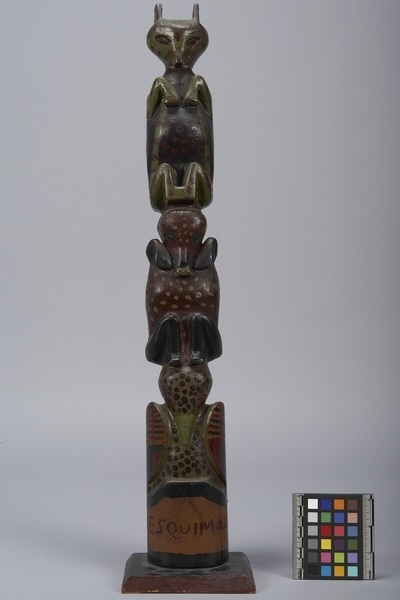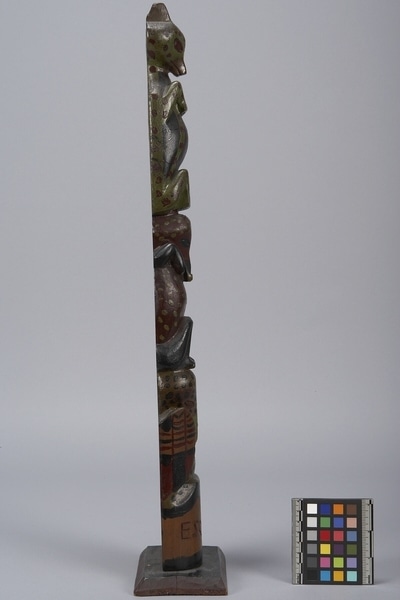Model Totem Pole Item Number: A2531 from the MOA: University of British Columbia




Description
Small totem pole with three figures. Topmost is a bear figure with a black body, green arms and legs, a red snout and eyes and red dots covering the body. The middle figure is wolf-like with a red body, black arms and legs and green dots covering the body. The bottom figure is a bird with a green head and body covered with black dots and red and black striped wings. The word "Esquimalt" is roughly carved across the lowest portion of the pole. The pole sits on a black and brown base.
History Of Use
Traditionally, Coast Salish sculptures took the form of large-scale houseposts and boards, which were decorated with realistic looking animal, human and supernatural figures. Totem poles, originally only carved by their northern neighbours, became more popular in the early 20th century as tourist art. Many scholars feel that traditional styles of Coast Salish "art" were overlooked because it expressed private, non-secular experiences of the makers and they were reticent to discuss it or sell it to individuals outside of their communities. Miniature carved objects, such as totem poles and canoes, were popular forms of tourist art in the 20th century and are found in many museum collections.
Cultural Context
contemporary art; tourist art
Item History
- Made in Esquimalt, British Columbia, Canada
- Owned by Walter C. Koerner before April 8, 1976
- Received from Walter C. Koerner (Donor) on April 8, 1976
What
- Name
- Model Totem Pole
- Identification Number
- A2531
- Type of Item
- totem pole
- Material
- cedar wood and paint
- Manufacturing Technique
- cut, smoothed, painted and carved
- Overall
- height 57.0 cm, width 12.5 cm, depth 9.0 cm
Who
- Culture
- Coast Salish: Songhees
- Previous Owner
- Walter C. Koerner
- Received from
- Walter C. Koerner (Donor)
Where
- Holding Institution
- MOA: University of British Columbia
- Made in
- Esquimalt, British Columbia, Canada
When
- Ownership Date
- before April 8, 1976
- Acquisition Date
- on April 8, 1976
Other
- Condition
- good
- Current Location
- Case 6
- Accession Number
- 0336/0125